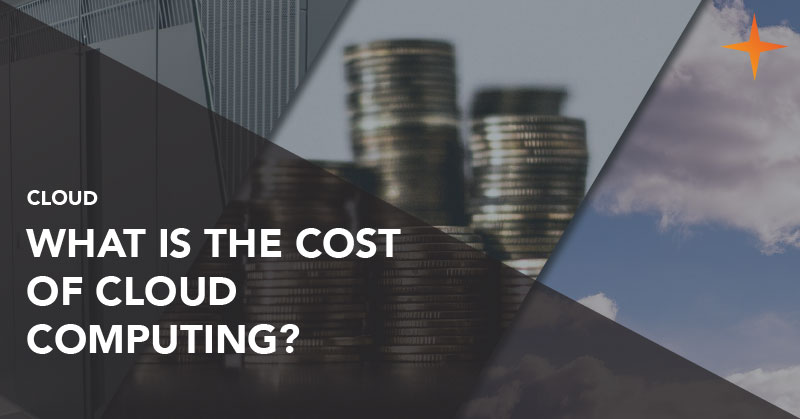Blog
What is the cost of cloud computing?
June 1st, 2015

One of the most commonly cited benefits of the cloud is its potential to reduce and optimise IT spend. With your data being stored in the provider’s data centre, you no longer require costly server equipment in-house, nor the cooling equipment, electricity bills and maintenance costs that come with it.
There are also no hardware or software upgrades to unexpectedly deal with and it’s commonly run on a per-user, per-month model – providing long-term cost savings too.
With cloud service providers regularly promoting all these benefits, and more, it can seem like a complete no-brainer. Surely every type of business should be adopting cloud!
Unfortunately, it’s not always the best fit for everyone, and one of the things you should be considering right now are the costs, and if your IT budget can cope with them?
What are the operating costs of cloud computing?
Cloud computing is a paradigm shift from using in-house infrastructure. With in-house infrastructure, you pay for the hardware and then can do whatever you want with it. With cloud infrastructure though, you get access to the hardware for ‘free’ but have to pay for anything and everything you do with it.
This includes paying for things you usually take for granted such as:
- Data storage space
- Disk read operations
- Disk write operations
- Sending data outside the server
- Running applications on the server
This means cloud can end up as a service which snowballs in price as you use it for more and more functions.
The good news is that these prices only get out of hand if you choose the wrong provider or service. The bad news is that choosing the wrong provider is very easy if you don’t know exactly what you’re doing.
If the proper analysis is performed before a vendor or solution is chosen, the operating costs should typically be less, or at worst case the same as delivering a service internally. But even if direct cost savings are minimal, you still gain access to top-class infrastructure and systems without the associated capital expenditure, and without needing to hire, train and retain staff to manage such a system.
How to choose the right cloud vendor?
It’s a bit of a wild-west out there at the moment and unfortunately, the cloud gold rush means you have cowboys looking to make a quick buck or amateurs putting their customers at risk. If you know what you are doing and fully understand your requirements it’s easy to assess the market… but most people don’t have that knowledge and need a bit of help.
The most common issue we see when helping turn around cloud projects is that the business didn’t have sufficient in-house IT knowledge and bought a cloud service the word of a sales guy.
Lots of vendors in the market are trying to make businesses believe adopting the cloud is as simple as buying a new server or replacing desktop PCs. Not only is this a lie but it opens the door to a host of hidden costs down the line.
Where are the hidden costs likely to spring from?
Hidden and unnecessary costs come from a variety of places in a cloud project:
- Misjudging the complexity and time involved in migration.
- Overlooking the correct levels of security and resilience when deciding on a vendor or solution.
- Believing that by choosing a cloud service, risk and management just vanish.
- Service or relationships falling apart.
- Pulling data from systems and keeping cloud systems talking to other solutions.
- Massively over-specifying cloud solutions and forgetting you can scale your operations to only what you use.
How can CIOs guard against the hidden costs?
As always if you are undertaking any project of size then it’s all about the planning. If you don’t feel 100% comfortable then pick up the phone and get an expert in. Even if it’s just for a day to sanity check everything. Too many CIOs are too proud to have their judgement double-checked, and this can prove costly – in many ways.
What is ransomware and how can businesses protect themselves?
Ransomware is a type of malware designed to block access to a user’s system or files until a ransom (usually paid in a cryptocurrency such as bitcoin) is given to the hacker. There’s a multitude of strains of ransomware out there. Notable examples include CryptoLocker, Crowti (also known as CryptoWall), Tescrypt or Teslacrypt, Teerac, Critrioni, Reveton, […]
The benefits of an email archiving solution
There are typically three ways in which businesses can archive their email; save absolutely everything, rely on users to archive emails or utilise an email archiving solution. With 269,000,000,000 (yes, that’s billion!) emails being sent and received every day, storing every single one is not really feasible. And with 200 billion of those being SPAM, […]
QuoStar gets gold partner green lights from Microsoft
For the third year running, Bournemouth and London based IT Services provider QuoStar has achieved a full flush of Green Lights in a recent Microsoft Gold Partner Customer Satisfaction Index survey. Microsoft Gold Partners are judged on a number of criteria in five key performance areas that measure customer satisfaction. TNS, one of the world’s […]
